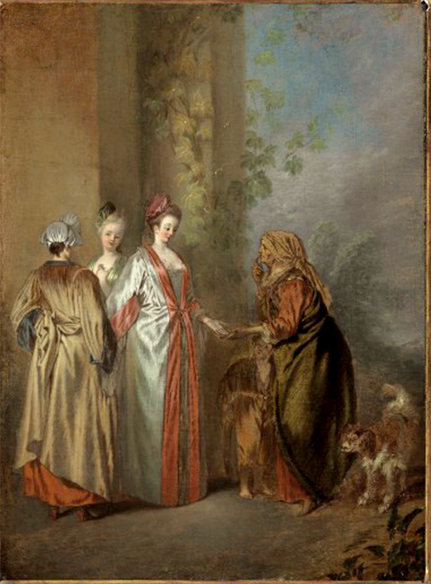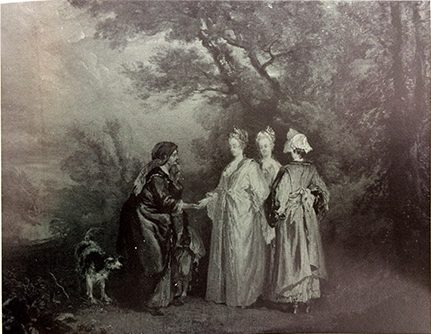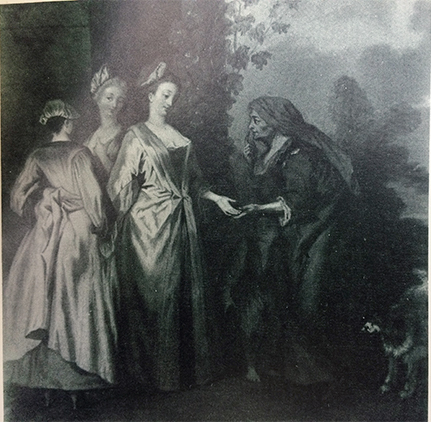
- Home Page
- Accepted
Paintings & Copies - Doubtful
Attributions - Doubtful Textual References
- Alternative
Titles - Collectors &
Museums - Bibliography
- Search Abecedario
- Watteau &
His Circle
COPIES AFTER WATTEAU’S LA DISEUSE D’AVENTURE
The large number of copies after Watteau’s La Diseuse d’aventure—almost fifty—is astounding. This is twice the number of copies after any other of the painter’s compositions. But why this picture, why this subject? It cannot be explained easily. One might think that a fête galante with amorous couples or musicians and dancers would have attracted a copyists’ attention, but such is not the case.
Of course, there are caveats. Our catalogue cannot surmount all the problems surrounding these copies. First, many of the references are to paintings without measurements or descriptions, and it is probable that some of them refer to the same painting coming up several times over. Occasionally, as in one example, a fortuitous correspondence of measurements allows us to associate a painting sold in 1768 from the de Merval collection (our copy 5) with one sold a century later from the Goerger collection, then with a lot in the Michel-Lévy sale in 1925, and finally to a German sale in 1990. Until now, each mention had been understood to represent a different work. For the greater part, however, such linkages are difficult to establish.
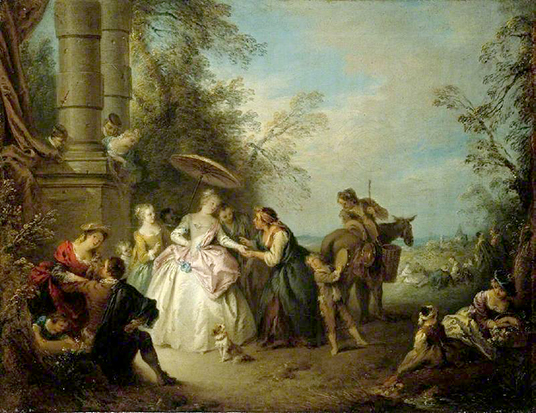
Jean-Baptiste Pater, The Fortune Teller, oil on canvas, 34 x 45.5 cm. Cambridge, The Fitzwilliam Museum.
Another problem in charting these copies is due to Pater and his shop having produced a great many variations on the theme of the gypsy fortune teller. Unlike Watteau’s focused narrative, Pater’s add many picturesque distractions, such as amorous couples and onlookers peering down from a raised, colonnaded structure—as demonstrated by the beautiful picture in the Fitzwilliam Museum. In the past, many dealers and collectors did not distinguish between the two artists’ works, and Pater’s were often sold under Watteau’s name, especially in eighteenth-century England, but in more recent years as well.
A good example of this mistaken identity is a painting that appeared in the Paris sale of Eugène Kraemer’s collection on June 2-5, 1913. Lot 81) was a Diseuse de bonne aventure attributed to the French school, eighteenth century. It was fully described but not illustrated in the catalogue. Adhémar listed it among the copies after Watteau’s composition, as did Macchia and Montagni, and then Rosenberg, and Rosenberg and Stewart. The painting has become firmly entrenched in the Watteau literature, even if only as a copy after Watteau. Yet the description in the Kraemer catalogue makes it apparent that Kraemer actually owned a picture by Pater or his shop. The mention of two couples at the left and several figures at the right, a woman carrying a basket of fruit, and the colonnaded structure are telling elements foreign to Watteau’s composition but expectable in Pater’s variations.
Other works embedded in the Watteau scholarship prove to be similarly erroneous. For instance, Adhémar cited a Watteau fortune teller in the collection of the abbé de Gevigney (his sale, December 1-29, 1779) but no such Watteau painting appeared in that sale. Perhaps she was thinking of a Manfredi (lot 657) that showed “Une Bohémienne qui dit la bonne aventure à une femme.” Nonetheless, reference to Gevigney’s purported fortune teller was repeated by Macchia and Montagni, but rightly refuted by Rosenberg. Despite such traps, we have compiled this listing of the many copies of Watteau’s Diseuse d’aventure while we continue to wonder why this picture attracted so many emulators.
La Diseuse d’aventure (copy 1)
Entered July 2020; revised April 2021
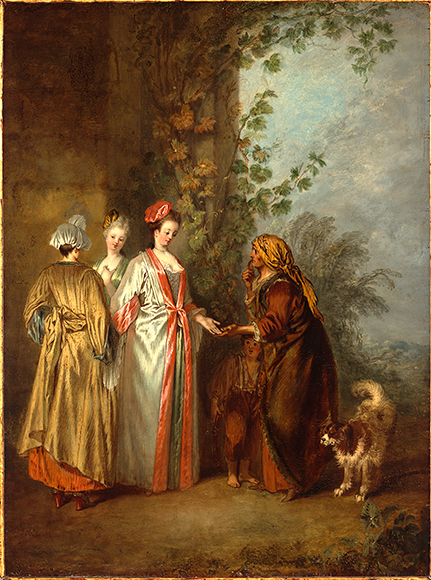
San Francisco, The Fine Arts Museums of San Francisco, Roscoe and Margaret Oakes Collection, inv.1968.03.01.
Oil on walnut panel
37.1 x 27.9 cm
ALTERNATIVE TITLES
The Fortune Teller
PROVENANCE
London, collection of Edward Abdy Fellowes (1895-1970; member of Parliament). His and others’ sale, London, Christie’s, July 13, 1951, lot 31: “WATTEAU . . . THE FORTUNE TELLER A group of three ladies, one having her fortune told by an old woman—on panel—15in. by 11in.” Bought for £30 by Belleroi, according to the Christie’s annotated copy of the sale catalogue now in the National Art Library, Victoria & Albert Museum, London.
New York, with Rudolf J. Heinemann (1901-1975; art dealer).
England, collection of R.E. Hornsby of Pulford Publicity, Ltd., c. 1957.
New York, with Rudolf J. Heinemann.
London, Agnew & Son (on consignment from Heinemann). Sold to the Roscoe and Margaret Oakes Foundation for the San Francisco Fine Arts Museum in 1968. The former director of the museum, Dr. Walter Heil, had known of the painting since 1959
EXHIBITIONS
Washington, Paris, Berlin, Watteau 1684-1721 (1984), cat. 8 (as by Watteau, The Fortune Teller (“La Diseuse Daventure”), lent by the Fine Arts Museums of San Francisco).
Paris, Grand Palais, Bohèmes (2012), cat. 20 (as by Watteau, La Diseuse d’aventure, lent by the Fine Arts Museums of San Francisco).
SELECT BIBLIOGRAPHY
Stewart, “16 Paintings in Search of an Artist” (1982).
Rosenberg and Stewart, French Paintings (1987), 318-23.
Rosenberg and Prat, Watteau, catalogue raisonné des dessins (1996), under cat. 34.
Temperini, Watteau (2002), cat. 9.
Glorieux, Watteau (2011), 107.
REMARKS
Although Heinemann claimed that the painting had come from an unnamed French private collection, it seems more likely that it had been in the collection of Edward Abdy Fellowes, KCB, CMG, MC, and then came up for sale at Christie’s in 1951. Fellowes’ painting and the San Francisco painting have the same measurements, both are on panel, and both gained public attention only in the early 1950s. As to the whereabouts of the painting between 1951 and its purchase for San Francisco, we have repeated Heinemann’s account although none of it is otherwise documented.
This version of Watteau’s Diseuse d’aventure was not known in the world of Watteau scholarship until it entered the collection of the San Francisco Museums in 1968. Despite a faint “Watteau” signature supposedly in the lower left corner (of which no trace remains), scholars were dubious from the start, and this is evident in the correspondence on file in the museum’s archive. When Michael Levey saw the painting in 1966 (despite reports that he favored the attribution), he seems to have come out against it; see Walter Heil’s letter to Heinemann of June 1, 1966 saying the latter shouldn’t be upset by Levey’s [negative] opinion. Again in 1983 Levey re-asserted his negative opinion of the work. Although Francis J. Watson favored the painting, he thought that the museum should not spend much money for it. Antoine Schnapper stated it was an “impossible attribution.” Even the museum’s curator, Marion Stewart, wrote against the work: “slight exaggerations of Watteau’s distinctive style, based upon comparisons with other paintings, suggest that our lovely panel is probably a period copy of the still-lost painting.” When Pierre Rosenberg decided to borrow the picture for the 1984 Watteau tercentenary exhibition, he wrote that he was not sure of the painting; the entry he prepared for the catalogue expressed those doubts openly and honestly. In the latter part of the twentieth century, critics frequently accepted the San Francisco painting, if nothing else as a matter of convenience—thus its inclusion in the monographs by Temperini and Glorieux.
The emergence in 2012 of the version now in the Lionel and Ariane Sauvage collection rekindled the question of the authenticity of the San Francisco painting. As Levey had noted in 1983, San Francisco’s painting was “too hard (in outlining and in handling of draperies, etc. . . . the left-hand figure in particular fails to convince as directly observed; she breathes copyist (albeit a skillful one) to my eye.” Indeed, the mechanical, diagonal highlights suggest the work of a dry copyist. Watteau’s handling of the brush is freer and less constrained. Also, as Rosenberg pointed out in the 1984 catalogue, when Watteau’s painting was in Oppenord’s collection in 1742, it was described as “gasté en partie,” that is, “partially ruined,” a condition that often befell Watteau’s pictures. His lack of technical care and his abuse of an oxidizer (Japan drier) often caused his pigments to turn dark and wrinkle. None of that can be seen in the San Francisco painting, but it is all too evident in the Sauvages’ work, even after restoration. In fact, the almost pristine quality of the San Francisco painting and the lack of visible pentimenti are marks against the work. It is too calculated and carefully finished to be by Watteau himself.
The San Francisco painting must have been copied directly from the Sauvages’ picture. The colors of the San Francisco panel are identical to those of its model, something that cannot be conveyed by an engraving. But where would this copy have been made—while it still was in Watteau’s studio or slightly later, when it was with Oppenord? That is an unanswerable but beguiling question.
La Diseuse d’aventure (copy 2)
Entered July 2020; revised May 2021

Whereabouts unknown.
Medium unknown
Measurements unknown
PROVENANCE
Paris, collection of Captain Barbier (d. 1752; capitaine au regiment d’Orléans). His sale, Paris, July 31, 1752: Watteau, Diseuse d’aventures. Cited in the Annonces, affiches & avis divers, July 31, 1752, p. 468: "PETIT CABINET. 1o. Quatorze Tableaux de différens Maîtres; entr'autres . . . la Diseuse de Bonne Aventure, de Wateau. . ."
SELECT BIBLIOGRAPHY
Dacier, Vuaflart, and Hérold, Jean de Jullienne et les graveurs (1921-29), under cat. 30.
Réau, “Watteau” (1928), under cat. 172.
Macchia and Montagni, L’opera completa di Watteau (1968), under cat. 37.
Washington, Paris, Berlin, Watteau, 1684-1721, under cat. 8.
Rosenberg and Stewart, French Painting (1987), 320.
REMARKS
Réau thought that the Barbier painting might have been the original by Watteau, probably because it was documented so close to the artist’s lifetime. This is a possibility, but there is no supporting evidence.
La Diseuse d’aventure (copy 3)
Entered July 2020

Whereabouts unknown
Medium unknown
35.5 x 25.4 cm
ALTERNATIVE TITLES
A Young Fortune Teller
PROVENANCE
London, collection of Dr. Robert Bragge (art dealer). His sale, London, Prestage, January 24-25, 1754, lot 36 [second day]: “WATTEAU . . . A young Fortune-teller telling a young Lady her Fortune [width] 10 [inch] 1 by [height] 1 [feet] 2 inch.” Sold together with lot 35 (Watteau, A Conversation of Comedians) for 15 guineas the pair to William Beckford Senior.
SELECT BIBLIOGRAPHY
Raines, “Watteaus and ‘Watteaus’ in England” (1977), 57, 62.
Washington, Paris, Berlin, Watteau 1684-1721 (1984), under cat. 8.
Rosenberg and Stewart, French Painting (1987), 320.
Glorieux, “L’Angleterre et Watteau” (2006), 58. 71.
REMARKS
Despite its proximity to Watteau’s lifetime, Bragge’s painting is unlikely to have been autograph; the picture had been with Oppenord in 1742, and, more important, we cannot even be certain that copied Watteau’s composition. The description of Bragge’s picture states that the fortune teller was young whereas Watteau depicted an old woman. Should the difference be explained as a variation introduced by a copyist or, equally possible, did Bragge own a variation on Watteau’s composition by an artist such as Pater?
La Diseuse d’aventure (copy 4)
Entered July 2020

Whereabouts unknown
Medium unknown
83.9 x 65 cm
ALTERNATIVE TITLES
Gypsies Telling Fortunes
PROVENANCE
London, sale, Prestage, February 26-28, 1765, paintings from Cardinal Mazarin, Prince Carignan, Duke of Valentinois, lot 11 [February 28]: “Watteau . . . Gypsies telling Fortunes—[Height] 2 [Feet] 7 [Inch.] [Width] 1 [Foot] 0 [Inch].” Sold for £13.2.6 to Bernhard, according to an annotated copy of the sale catalogue in the National Art Library, Victoria & Albert Museum, London.
SELECT BIBLIOGRAPHY
Goncourt, Catalogue raisonné (1875), cat. 127.
Dacier, Vuaflart, and Hérold, Jean de Jullienne et les graveurs (1921-29), cat.
Macchia and Montagni, L’opera completa di Watteau (1968), under cat. 37.
Washington, Paris, Berlin, Watteau 1684-1721 (1984), under cat. 8.
Rosenberg and Stewart, French Painting (1987), 320.
Glorieux, “L’Angleterre et Watteau” (2006), 59.
REMARKS
This was a noticeably large version of Watteau’s composition, not matched by other recorded pictures. De Goncourt seems to have thought that the painting sold in 1765 and the one sold from the de Merval collection in 1768 (our copy 5), both noticeably large, were one and the same, and might have been Watteau’s original picture.
It is odd that modern critics such as Réau, Adhémar, and Ferré omitted mention of the painting in the 1765 sale.
La Diseuse d’aventure (copy 5)
Entered July 2020; revised August 2020
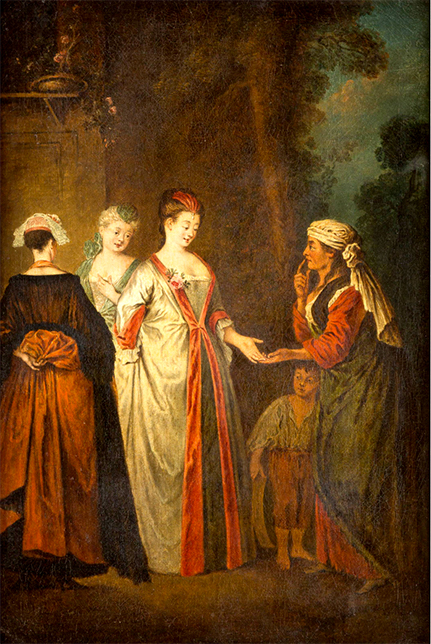
Whereabouts unknown
Oil on canvas
75 x 58 cm
ALTERNATIVE TITLES
La Bohémienne
PROVENANCE
Paris, collection Monsieur de Merval. His sale, Paris, May 9, 1768, lot 130: “La Bohémienne de Watteau, sujet composé de 4 figures, peint sur toile, de 2 pieds 4 pouces de haut, sur 22 pouces de large.” Sold for 240.1 livres to Langlier.
Paris, collection of Monsieur Goerger. His sale, Paris, February 26, 1880, lot 12: “WATTEAU (ANTOINE) . . . La Diseuse de bonne aventure. Trois jeunes dames sont réunies dans un parc: une, au centre, portant un pardessus en satin blanc doublé de rose, montre sa main à une vieille bohémienne. Celle-ci, vue de profil, un mouchoir blanc noué autour de la tête, le doigt sur la bouche, lui fait une prédiction qui la fait sourire; près d’elles, un petit mendiant tenant un tambour de basque; à gauche, une jeune femme, vue de dos, coiffée d’un bonnet de dentelles, le cou nu, les épaules couvertes d’une mantilla noire, la main au dos tenant son jupon. Au second plan, une troisième jeune femme vêtue d’une robe bleue.
Ce beau tableau, qui a la franchise, le brilliant et la fermeté des belles oeuvre de ce maître, a été gravé avec quelques variantes par Laurent Cars.
Gravé par L. Gaucherel. Toile. Haut., 75 cent.; larg., 58 cent.”
Sold for 15,000 francs to Brame, according to an annotated copy of the sale catalogue in the Bibliothèque national.Paris, collection of Henri Michel-Lévy (artist; 1848-1914). His sale, Paris, Galerie Georges Petit, June 17-18, 1925, lot 161: “WATTEAU (JEAN-ANTOINE) . . . La Diseuse d’aventure. Trois jeune femmes sont réunies à l’angle d’un mur enguirlandé de feuillage. L’une d’elles tend la main à une Bohémienne, en corsage rouge et grande mante verte, pour qu’elle y lise sa destinée. Un garçonnet se blottit contre la diseuse d’aventure, un tambourin à la main. Fond de verdure. Toile. Haut., 75 cent.; larg., 58 cent.
Composition gravée par L. Cars, avec la mention: du Cabinet de M. Oppenort, d’après le tableau original peint par Watteau, de même grandeur.
Les dimensions de la gravure sont 0,339 millim. X 0,274 millim.
L’écart des dimensions est trop sensible pour ne pas admettre que la gravure ait été faite d’après un autre original. Elle présente d’ailleurs de notables variantes. Le format même des figures du présent tableau est inusité dans l’oeuvre de Watteau et la facture nous donne à supposer que nous sommes en présence d’une oeuvre du début du l’artiste, qu’il aurait plus tard reproduite telle qu’elle apparaît dans la gravure.”Annecy-le-Vieux, collection of Monsieur Hervieu, c. 1979
Zurich, sale, Galerie Köller, May 16-17, 1980, lot 5183: “WATTEAU, ANTOINE . . . und sein ATELIER. »La Diseuse d’aventures«. Öl auf Lwd. 72 x 59. (35 000.-- / 45 000.--) Bestätigung von Alexandre Ananoff. TAFEL 46.”
Germany, Rhenish private collection. This collector’s sale and others, Düsseldorf, Hargesheimer Auktionen, September 14, 2019, lot 2127: “ANTOINE WATTEAU (CIRCLE) . . . THE FORTUNE TELLER / Oil on canvas (relined). 84,5 x 58 cm (F. 100 72 cm). Verso: On the canvas stretcher two old coat of arms seals as well as two old labels, one handwritten. ‘The fortune teller’ important early work bought in Brussels 1892’ and the second Nettoyage Restauration Rentoilage DE TABLEAUX. Frochol Peintre Dijon Rue de l’École de Droit 3 y’ Part. min. restored. Frame. Provenance: Rhenish Private Collection. €1.500,- “
Düsseldorf, sale, Hargesheimer Auktionen, September 12, 2020, lot 1613: “ANTOINE WATTEAU (CIRCLE) . . . THE FORTUNE TELLER / Oil on canvas (relined). 84,5 x 58 cm (F. 100 72 cm). Verso: On the canvas stretcher two old coat of arms seals as well as two old labels, one handwritten. ‘The fortune teller’ important early work bought in Brussels 1892’ and the second Nettoyage Restauration Rentoilage DE TABLEAUX. Frochol Peintre Dijon Rue de l’École de Droit 3 y’ Part. min. restored. Frame. Provenance: Rhenish Private Collection. €1.200- €2,400. “
SELECT BIBLIOGRAPHY
Goncourt, Catalogue raisonné (1875), cat. 127.
Mollet, Watteau (1883), 68.
Zimmermann, Watteau (1912), pl. 181.
Dacier, Vuaflart, and Hérold, Jean de Jullienne et les graveurs (1921-29), 1: p. 259; 3: under cat. 30.
Réau, “Watteau” (1928), under cat. 172.
Adhémar, Watteau (1950), cat. 48.
Macchia and Montagni, L’opera completa di Watteau (1968), under cat. 37.
Ferré, Watteau, 1972, under cat. B 25.
Washington, Paris, Berlin, Watteau 1684-1721 (1984), under cat. 8.
Rosenberg and Stewart, French Paintings (1987), 318, 320.
REMARKS
Because of the unusually large, almost identical measurements of the Merval, Goerger, Michel-Lévy, and Köller copies of La Diseuse d’aventure, we have linked them as referring to one picture, an idea that seems not to have occurred to other scholars. When the painting was sold in 1925, there was mention of “notables variantes” between Cars’ engraving and the Michel-Lévy painting but without identification what they were. One of the most evident is the inclusion of a still life with flowers and a handled vessel placed on a shelf on the wall at the left. The same feature is present in the painting in the Hervieu collection, and the one sold in Germany in 1980 and then in Switzerland in 2013.
Regarding its presence in the Hervieu collection, see the October 19, 1979, letter from Jean Cailleux to the owner, now in the archives of Marianne Roland Michel in the Musée de la ville de Paris. Curiously, in the most recent sale the painting gained an additional 10 cm in height, and labels on the back attesting to the painting’s provenance from Brussels in 1892 and its relining in Dijon. Nonetheless, photographs reaffirm that it is the same painting as the one formerly in the Michel-Lévy and Hervieu collections, and in the Köller sale.
Without proof, Goncourt referred to the Merval picture “Un original” of the painting engraved by Cars, presumably meaning that the Merval picture was the one engraved by Cars, not that there was more than one original. Goncourt appears to claim that this picture is the one sold in London in February 1765 (our cat. 4), a sale that contained pictures from the Mazarin and Carignano collections, but without any supporting documentation. Zimmerman and Réau accepted the Michel-Lévy painting as Watteau’s original picture. Adhémar proposed it as one of two leading candidates to be from Watteau’s hand. The Michel-Lévy painting disappeared from sight after its sale in 1925, and fell from favor after the appearance of the San Francisco version. Its provenance from Michel-Lévy went unnoticed when it reappeared in the 1970s and again in the 1990s.
La Diseuse d’aventure (copy 6)
Entered July 2020

Whereabouts unknown
Medium unknown
Measurements unknown
ALTERNATIVE TITLES
A Landscape with the Fortune-Teller
PROVENANCE
Paris, with Jean-Baptiste Pierre Le Brun (1748-1813; painter and art dealer). His sale, London, March 18-19, 1785, lot 75: ”Watteau --- A ditto [landscape and figures] with the fortune-teller.” Sold for £23.2 to Bainbridge.
SELECT BIBLIOGRAPHY
Washington, Paris, Berlin, Watteau 1684-1721 (1984), under cat. 8.
Rosenberg and Stewart, French Painting (1987), 320.
REMARKS
This picture, which went unnoticed until the Watteau tercentenary, had a pendant, lot 76 in the 1785 sale, described as “A Conversation,” i.e., a fête galante.
La Diseuse d’aventure (copy 7)
Entered July 2020

Whereabouts unknown
Medium unknown
Measurements unknown
ALTERNATIVE TITLES
The Fortune Teller
PROVENANCE
London, with Mr. Foxall. Sale, London, Christie’s, February 10-11, 1786, lot 37: “Watteau — Fortune Teller.” Sold with the following lot (38: “Rubens — The companion, an allegorical sketch”) for 11 guineas the pair to Tassaert.
SELECT BIBLIOGRAPHY
Rosenberg and Stewart, French Painting (1987), 320.
REMARKS
Foxall’s ownership of the painting at the time of the 1786 auction is indicated in the auction house’s annotated copy of the catalogue now in the National Art Library, Victoria & Albert Museum, London.
La Diseuse d’aventure (copy 8)
Entered July 2020

Whereabouts unknown
Oil on canvas
89 x 78.5 cm (including the frame)
ALTERNATIVE TITLES
Fortune Teller
PROVENANCE
London, with Noel Joseph Desenfans (1744-1807; art dealer). His sale, London, April 8ff, 1786, lot 298: “Watteau—Fortune teller 2 ft 9 by 2 ft 5, on canvas.” Sold for £16.16, according to an annotated copy of the sale catalogue in the Frick Art Reference Library.
SELECT BIBLIOGRAPHY
Dacier, Vuaflart, and Hérold, Jean de Jullienne et les graveurs (1921-29), under cat. 30.
Réau, “Watteau” (1928), under cat. 172.
Macchia and Montagni, L’opera completa di Watteau (1968), under cat. 37.
Washington, Paris, Berlin, Watteau 1684-1721 (1984), under cat. 8.
Rosenberg and Stewart, French Painting (1987), 320.
REMARKS
Although one of the largest recorded copies of La Diseuse d’aventure, the measurements of this painting reputedly included the frame. Without it, this picture is not that much larger than our copy 4 (83.9 x 65 cm) and one wonders if they are not one and the same.
La Diseuse d’aventure (copy 9)
Entered July 2020

Whereabouts unknown
Medium unknown
Measurements unknown
ALTERNATIVE TITLES
The Fortune Teller
PROVENANCE
Petworth House, Sussex, collection of George O’Brien Wyndham, 3rd Earl of Egremont (1751-1837). His sale, London, Christie’s, March 7-8, 1794, lot 54 (March 8): “Wattaux . . . The Fortune teller, a most beautiful picture.” Sold for £27.6.
SELECT BIBLIOGRAPHY
Glorieux, “L’Angleterre et Watteau” (2006), 67.
REMARKS
According to Glorieux, the painting sold for £27.16.6 to Parsons.
La Diseuse d’aventure (copy 10)
Entered July 2020
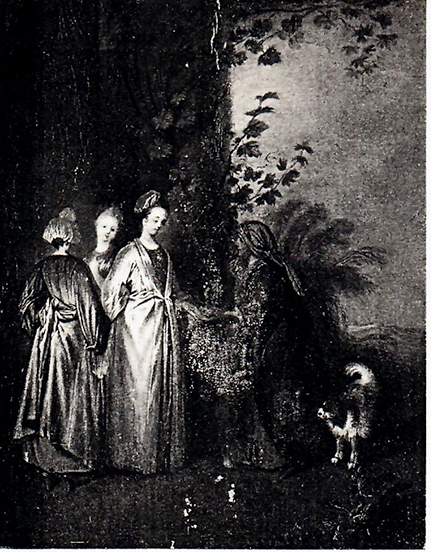
Northern California, private collection
Oil on canvas
Measurements unknown
SELECT BIBLIOGRAPHY
Washington, Paris, Berlin, Watteau 1684-1721 (1984), under cat. 8.
Rosenberg and Stewart, French Painting (1987), 318.
Jeffares, Pastellists.
REMARKS
Exceptionally, this copy of La Diseuse d’aventure is signed, by Anne Bricollet (1753-1833), and is dated 1798. The artist is known by only two other works, one dated 1785 and the other 1797. Her rendering of La Diseuse d’aventure was brought into the museum shortly after the institution had announced the purchase of what they believed was Watteau’s original painting (our copy 1). Her signature was misread as “Bricoller” and nothing was known about her. She was active in Bourg-en-Bresse, far from Paris, and thus she must have depended on Cars’ engraving of the composition. Despite Rosenberg’s text in the 1984 tercentenary exhibition catalogue, the painting did not enter the San Francisco museum’s permanent collection.
La Diseuse d’aventure (copy 11)
Entered July 2020; revised September 2020

Whereabouts unknown
Medium unknown
Measurements unknown
ALTERNATIVE TITLES
Fortune Tellers
PROVENANCE
Sale, London, Greenwood, April 16-18, 1806, lot 44: “Watteau . . . Fortune Tellers.”
REMARKS
In that this copy and the one sold at Christies on July 2, 1810 (our copy 12) both cite the presence of "fortune tellers" in the plural, they may be one and the same painting. The 1806 sale had two other paintings given to Watteau: lot 52, “A Fête,” and lot 82, a “Fête Champêtre.”
La Diseuse d’aventure (copy 12)
Entered July 2020; revised September 2020

Whereabouts unknown
Medium unknown
Measurements unknown
ALTERNATIVE TITLES
Fortune Tellers and Companions
PROVENANCE
London, collection of Joseph Hunt. His sale, Christie’s, July 2, 1810, lot 69: “Watteau. . . Fortune Tellers and Companions—style of.” The picture sold for £8.0 to Charles Henry Core according to an annotated copy of the sale catalogue in the National Art Library, Victoria & Albert Museum, London.
REMARKS
The painting was listed merely as “style of Watteau,” suggesting that it was somewhat inferior. In that this copy and the one sold at Greenwood in 1806 (our copy 11) both cite the presence of "fortune tellers" in the plural, they may be one and the same painting.
La Diseuse d’aventure (copy 13)
Entered July 2020

Whereabouts unknown
Medium unknown
Measurements unknown
ALTERNATIVE TITLES
A Gypsy Telling a Young Woman of Quality Her Fortune
PROVENANCE
London, sale, “the European Museum,” May 23, 1811, lot 87: “Watteau . . . . A Gypsy telling a Young Lady of Quality her Fortune, and a Musical Conversation, its companion, from the Palace of Frederick the Great, at Sans Souci—a pair.” Sold for £9.9 the pair, according to an annotated copy of the sale catalogue.
REMARKS
Despite the notable provenance claimed for these two paintings, which itself must be questioned, not all the paintings in Berlin had impeccable attributions
La Diseuse d’aventure (copy 14)
Entered July 2020

Whereabouts unknown
Medium unknown
Measurements unknown
ALTERNATIVE TITLES
The Fortune Teller
PROVENANCE
London, collection of H. Broadwood. His sale, London, Phillips, June 28-29, 1831, lot 136: “A. Watteau . . . The Fortune Teller.” The picture bought in at 31 guineas.
La Diseuse d’aventure (copy 15)
Entered July 2020

Whereabouts unknown
Medium unknown
Measurements unknown
ALTERNATIVE TITLES
La Diseuse de bonne aventure
PROVENANCE
Paris, sale, Hôtel des commissaires-priseurs, April 21, 1836, lot 49: “WATTEAU (attribué à). La diseuse de bonne aventure; composition traitée avec esprit.”
REMARKS
The cautionary “attribué à” attached to the attribution suggests that the quality of the picture was visibly inferior.
La Diseuse d’aventure (copy 16)
Entered July 2020

Whereabouts unknown
Medium unknown
Measurements unknown
ALTERNATIVE TITLES
A Pastoral Scene, the Fortune Teller
PROVENANCE
London, with Edward Solly (1766-1849; merchant and art dealer). Consigned to Foster, sale, November 7-8, 1836, lot 172: “Watteau . . . A Pastoral Scene, the Fortune Teller.” Sold to “George” for £3.18 or £3.10.
London, with George (dealer). Consigned to Foster, sale, March 31, 1837, lot 166: “Watteau . . . A Pastoral Scene, the Fortune Teller.”
REMARKS
That Solly and George were the consignors in the 1836 and 1837 sales is indicated in the annotated copies of the sale catalogues in the National Art Library, Victoria & Albert Museum, London.
La Diseuse d’aventure (copy 17)
Entered July 2020; revised September 2020

Whereabouts unknown
Medium unknown
Measurements unknown
ALTERNATIVE TITLES
La Bonne aventure
A Garden Scene with the Fortune Teller
PROVENANCE
Paris, Garde Meuble (?)
London, with Mr. Morant (dealer). Consigned to Christie’s, sale, May 6, 1837, lot 98: “Watteau . . . La bonne aventure. This picture was formerly in the Garde Meuble.” Bought in at 69 guineas.
London, with Morant or Edwards (painting dealer). Consigned to Phillips, sale, May 4-5, 1838, lot 74: “A. WATTEAU. A Garden Scene, with the Fortune Teller.” Bought in at £39.18 (or sold for £40 to Billington).
REMARKS
This copy of La Diseuse d’aventure seems to have been overlooked in the Watteau literature.
La Diseuse d’aventure (copy 18)
Entered July 2020

Whereabouts unknown
Medium unknown
Measurements unknown
ALTERNATIVE TITLES
La Diseuse de bonne aventure
PROVENANCE
Paris, collection of Monsieur Fossard (Fossart). His sale April 24-25, 1838. lot 73: “WATEAU . . La diseuse de bonne aventure. Trois jeunes dames se sont présentées à elle. Ce tableau est gravé.” Sold for 315 francs to Lieneuville, according to annotated copies of the sale catalogue in the Frick Art Reference Library, New York, and the Bibliothèque nationale, Paris.
SELECT BIBLIOGRAPHY
Dacier, Vuaflart, and Hérold, Jean de Jullienne et les graveurs (1921-29), under cat. 30.
Réau, “Watteau” (1928), under cat. 172.
Adhémar, Watteau (1950), under cat. 48.
Macchia and Montagni, L’opera completa di Watteau (1968), under cat. 37.
Washington, Paris, Berlin, Watteau 1684-1721 (1984), under cat. 8.
Rosenberg and Stewart, French Paintings (1987), 320.
La Diseuse d’aventure (copy 19)
Entered March 2021

Whereabouts unknown
Oil on canvas
36 x 45 cm
ALTERNATIVE TITLES
La Diseuse de bonne aventure
REMARKS
In that this picture was horizontal in format, there is the possibility that it was a variation of Pater’s composition of bathing women.
La Diseuse d’aventure (copy 20)
Entered July 2020

Whereabouts unknown
Materials unknown
Measurements unknown
ALTERNATIVE TITLES
La Bohémienne
La Bonne aventure
PROVENANCE
Near Paris, in a country auction, bought by M. Malinet for 25 francs. He sold it for 1,500 francs.
SELECT BIBLIOGRAPHY
Hédouin, “Watteau,” (1845), under cat. 64.
Hédouin, Mosaïque (1854), under cat. 65.
Cousin, Le Tombeau de Watteau (1865), 25.
Adhémar, Watteau (1950), under cat. 48.
Macchia and Montagni, L’opera completa di Watteau (1967), under cat. 37.
Washington, Paris, Berlin, Watteau 1684-1721 (1984), under cat. 8.
REMARKS
Both Hédouin and Cousin reported the tale that Malinet had bought this painting for little money and then resold it soon thereafter for great profit. All this supposedly happened shortly before they were writing, which would mean c. 1840. The tale suggests that the picture had not been sold in a major Parisian venue. Both writers insist it was a small painting, but this is a highly subjective measurement. Macchia and Montagni suggested that Malinet’s painting could be identified with the one in the Michel-Lévy collection, but this is unfounded. There were a substantial number of “small” copies of this painting on the Paris market in the mid-nineteenth century.
La Diseuse d’aventure (copy 21)
Entered July 2020

Whereabouts unknown
Materials unknown
Measurements unknown
ALTERNATIVE TITLES
Jeune femme se faisant dire la bonne aventure
PROVENANCE
Paris, sale, Hôtel des commissaires-priseurs, March 24-25, 1840, lot 82: “WATEAU (Ecole de) . . . Jeune femme se faisant dire la bonne aventure.” Sold for 66 francs.
REMARKS
The cautionary attribution “École de” allows one to wonder whether the composition was by Watteau or one of his followers, or whether it was thought the composition was by Watteau but the execution was not.
La Diseuse d’aventure (copy 22)
Entered July 2020

Whereabouts unknown
Medium unknown
Measurements unknown
ALTERNATIVE TITLES
Une Dame se fait dire la bonne fortune
PROVENANCE
Évry-sur-Seine (Essonne), Château de Petit-Bourg. Sale, Paris, Place Vendôme, April 22-28, 1840, lot 40: “WATTEAU (École de). . . . Société dans un parc: une dame se fait dire la bonne fortune.” Sold for 152 francs.
REMARKS
The cautionary attribution “École de” leaves open whether the composition was by Watteau or one of his followers, or whether the composition was attributable to Watteau but not the execution.
La Diseuse d’aventure (copy 23)
Entered July 2020

Whereabouts unknown
Materials unknown
Measurements unknown
PROVENANCE
London, collection of “Monsieur de St. Denis, late of Paris.” His sale, London, Phillips, March 23-24, 1842, lot 154: “WATTEAU . . . La Disuse de bon Aventure.”
REMARKS
This copy of La Diseuse d’aventure seems to have been overlooked in the Watteau literature.
La Diseuse d’aventure (copy 24)
Entered July 2020; revised September 2020

Whereabouts unknown
Medium unknown
Measurements unknown
ALTERNATIVE TITLES
The Fortune Teller
PROVENANCE
London, with Mr. Durand. Sale, London, Phillips, April 30, 1844, lot 97: “WATTEAU. . . . THE FORTUNE TELLER.” Sold for 79 guineas according to the annotated copy of the sale catalog in the Rijksbureau voor Kunsthistorische Documentatie.
La Diseuse d’aventure (copy 25)
Entered July 2020

Whereabouts unknown
Medium unknown
Measurements unknown
PROVENANCE
Paris, Hôtel des ventes mobilières, May 8-10, 1845, lot 178: Du Même [“WATTEAU (Attribué à)], La Diseuse d’Aventures.”
La Diseuse d’aventure (copy 26)
Entered July 2020; revised September 2020

Whereabouts unknown
Medium unknown
Measurements unknown
PROVENANCE
Paris, collection of Monsieur Stevens. His sale, Paris, Hôtel des ventes, March 1-4, 1847, lot 319: “WATTEAU. . . .La Diseuse de bonne aventure. De jeunes dames, curieuses de connaître leur avenir, se sont réunies dans un parc pour entendre d’une devineresse leur horoscope.” Sold for 450 francs according to the annotated copy of the sale catalog in the Rijksbureau voor Kunsthistorische Documentatie.
SELECT BIBLIOGRAPHY
Washington, Paris, Berlin, Watteau 1684-1721 (1984), under cat. 8.
Rosenberg and Stewart, French Paintings (1987), 320.
La Diseuse d’aventure (copy 27)
Entered July 2020

Whereabouts unknown
Oil on canvas
Measurements unknown
ALTERNATIVE TITLES
La Diseuse de bonne aventure
PROVENANCE
Le Midi de la France, private collection. Sale, Paris, Hôtel des ventes, November 22-24, 1847, lot 250: “WATTEAU (Composition de). La diseuse de bonne aventure. Sujet connu par la gravure de Cars. T.” Sold for 21.5 francs, according to an annotated copy of the sale catalogue in the Frick Art Reference Library, New York.
REMARKS
The auctioneer took particular care in suggesting that that while the composition was by Watteau, the execution was not.
La Diseuse d’aventure (copy 28)
Entered July 2020

Whereabouts unknown
Medium unknown
Measurements unknown
ALTERNATIVE TITLES
La Bonne aventure
PROVENANCE
Paris, sale, Hôtel des ventes, January 5-6, 1848, lot 53: “WATTEAU (d’après). La Bonne Aventure.” Sold for 20 francs.
La Diseuse d’aventure (copy 29)
Entered July 2020

Whereabouts unknown
Medium unknown
Measurements unknown
PROVENANCE
Paris, sale, Hôtel des commissaires-priseurs, February 29, 1856, lot 77: “DU MÊME [WATTEAU, (ANT)]. La Diseuse de bonne aventure. Premiere manière du maître.”
REMARKS
It is quite unusual, especially in the 1850s, for the auctioneer to comment about the date of the painting.
La Diseuse d’aventure (copy 30)
Entered July 2020; revised September 2020

Whereabouts unknown
Medium unknown
Measurements unknown
ALTERNATIVE TITLES
La Diseuse de bonne aventure
PROVENANCE
Lyon, collection of Monsieur ***. His sale, Paris, Hôtel des commissaires-priseurs, April 29, 1861, lot 26: “WATTEAU (d’après). . . . La Diseuse de bonne aventure. Bonne et ancienne copie d’une exécution soignée.”
La Diseuse d’aventure (copy 31)
Entered July 2020

Whereabouts unknown
Medium unknown
60 x 70 cm
ALTERNATIVE TITLES
Scène champêtre
PROVENANCE
Collection of Comte de S., pair de France. His sale, Paris, May 15-17, 1866, lot 209: “WATTEAU (ANTOINE) . . . Scène champêtre. Ce tableau, embelli de nombreux personnages, est agréable de composition et d’un beau coloris. Une femme tient la main d’une jeune fille à qui elle paraît dire sa bonne aventure. H. 60 c. l., 70 c.”
REMARKS
The painting’s horizontal format and the mention of “nombreux personnages” suggest that the painting may have been by Pater or his shop, rather than by Watteau.
La Diseuse d’aventure (copy 32)
Entered July 2020

Whereabouts unknown
Oil on canvas
60 x 50 cm
PROVENANCE
Paris, collection of Doctor Gaston Gaudinot. His sale, Paris, February 15-16, 1869, lot 119: “WATTEAU . . . La Diseuse d’aventure. Première manière du maître? Dans un parc, trois jeunes femmes écoutent une vielle diseuse de bonne aventure; l’une d’elles lui donne sa main et se laisse prédire l’avenir. Un jeune garçon écoute et paraît surpris: un chien est près de lui. Gravé. Toile. Haut., 60 cent.; larg., 50 cent.” Sold for 500 francs.
SELECT BIBLIOGRAPHY
Dacier, Vuaflart, and Hérold, Jean de Jullienne et les graveurs (1921-29), under cat. 30.
Réau, “Watteau” (1928), under cat. 172.
Adhémar, Watteau (1950), under cat. 48.
Macchia and Montagni, L’opera completa di Watteau (1968), under cat. 37
Washington, Paris, Berlin, Watteau 1684-1721 (1984),under cat. 8.Rosenberg and Stewart, French Paintings (1987), 320.
REMARKS
Because of their almost identical dimensions, it is tempting to think that Gaudinot’s painting is the same one that was in the collection of Thomas J. Bryan and then the collection of the New-York Historical Society (our cat. 33). However, as the Gaudinot sale was in Paris at the start of 1869 and Bryan died the next year in New York, the timing is perhaps too close for it to have made the trans-Atlantic crossing and entered Bryan’s collection.
La Diseuse d’aventure (copy 33)
Entered July 2020; revised September 2020
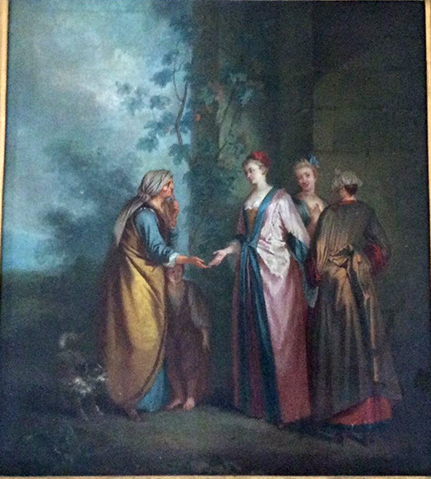
Whereabouts unknown
Oil on canvas
59.7 x 54.6 cm
ALTERNATIVE TITLES
The Fortune Teller
PROVENANCE
New York, collection of Thomas J. Bryan (c.1800-1870). Bequeathed to the New-York Historical Society.
New York, New-York Historical Society, inv. + B340. Sold, New York, Sotheby Parke-
Bernet, December 2, 1971, lot 153: “SCHOOL OF ANTOINE WATTEAU . . . THE
FORTUNE TELLER 23 ½ 21 ½ inches +B 340.” Sold for $275.New York, collection of Jules Szawas.
Ebay, December 2017, Antoine Watteau, The Fortune Teller, seller izya, $12,500. The back of the frame still bears the stenciled inventory number 340, and pasted on a stretcher is the printed paper label from the New-York Historical Society: "B-340. The Fortune Teller. (23½ x 21.) Antoine Watteau. (Bryan Collection.)"
SELECT BIBLIOGRAPHY
Monod and Einstein, “Le Musée de la société historique” (1906), 250-51.
Réau, “Watteau” (1928), under cat. 172.
Adhémar, Watteau (1950), under cat. 48.
Macchia and Montagni, L’opera completa di Watteau (1968), under cat. 37.
Washington, Paris, Berlin, Watteau 1684-1721 (1984), under cat. 8.
Rosenberg and Stewart, French Paintings (1987), 319.
REMARKS
All twentieth-century critics labeled this picture a copy, but earlier it was undoubtedly thought to be by Watteau. It is in the same direction as Cars’ engraving after Watteau's composition and is more open at each side. Unlike Watteau’s painting and the copy in San Francisco, this version is much larger. Its size is essentially the same as that of the version in the Gaudinot sale in 1869 (our copy 19).
La Diseuse d’aventure (copy 34)
Entered July 2020; revised September 2020

Whereabouts unknown
Materials unknown
Measurements unknown
ALTERNATIVE TITLES
The Fortune Teller
PROVENANCE
London, sale, Foster, April 17, 1872, lot 42: “WATTEAU . . . The Fortune Teller.” According to Foster's annotated copy of the sale catalogue in the National Art Library, Victoria & Albert Museum, London, the painting was consigned by Adams and did not sell.
La Diseuse d’aventure (copy 35)
Entered July 2020

Whereabouts unknown
Medium unknown
Measurements unknown
ALTERNATIVE TITLES
La Diseuse de bonne aventure.
PROVENANCE
Toulon, Collection of Monsieur M***. His sale, Paris, Hôtel Drouot, January 18, 1882, lot 51: “WATTEAU (genre de ). La Diseuse de bonne aventure.”
REMARKS
The qualifying “genre de Watteau” is ambiguous; does it refer to the composition or the style?
La Diseuse d’aventure (copy 36)
Entered July 2020
Whereabouts unknown
Oil on canvas
32 x 25 cm
ALTERNATIVE TITLES
La Bonne aventure
La Diseuse de bonne aventure
The Fortune Teller
PROVENANCE
Paris, collection of Ernest May. His sale, Paris, Galerie Georges Petit, June 4, 1890, lot 131: “WATTEAU (Attribué à) / La Diseuse de bonne aventure. C’est une vieille bohémienne avec son chien, ayant à sa droite une jeune garçon; elle examine la main d’une jeune femme suivie de deux de ses compagnes, qui écoutent en souriant la prédiction. Cadre Louis XV, en bois sculpté. Toile. Haut., 32 cent.; larg., 25 cent.” Sold for 2,150 francs.
Paris, sale, Nouveau Drouot, June 6, 1984, lot 11: “Attribué à François OCTAVIEN . . . LA BONNE AVENTURE / Toile. Haut. : 35 cm. Larg. : 26 cm / Beau cadre d’époque Louis XIV. Finement sculpté d’attributs et doré. Dim. du cadre: Haut.: 54 cm. Larg.: 44.5 cm.”
Paris, unidentified venue, sale, April 29, 1994, lot 88: “ÉCOLE FRANÇAISE du XVIIIe siècle . . . LA DISEUSE DE BONNE AVENTURE / Toile. Beau cadre en chêne sculpté et doré de fleurs, attributs et rinceaux d’époque Régence. Haut.: 35,5 cm – Larg.: 26 cm. 30 000/40 000.”
Sale, New York, Christie’s, September 30, 2003, lot 393: “AFTER JEAN ANTOINE WATTEAU / ‘La diseuse d’aventure’ / oil on canvas / 13 7/8 x 10 1/8 in. (35.4 x 26.7 cm.) / Estimate: $4,000-6,000. The original by Watteau is in the Fine Arts Museum, San Francisco. In a Regence carved and gilt frame.” Bought in.
New York, sale, Christie’s, February 4, 2004, lot 104: “AFTER ANTOINE WATTEAU / ‘La
diseuse de bonne aventure’ / oil on canvas / 14 x 10 in. (35.4 x 26.7 cm.) / Estimate $2,000-3,000 / The original by Watteau is in the Fine Arts Museums of San Francisco. / In a Regence carved and gilt frame.” Sold for $1,434 including premium.New York, L’Antiquaire & The Connoisseur, c. 2004.
New York, sale, Christie’s, June 9, 2010, lot 300: After Jean Antoine Watteau, The Fortune Teller, oil on canvas, 13 ¾ x 10 in (34.9 x 25.4 cm.) In a Regence carved and gilt frame. Est. $6,000-8,000. Sold for $5,000.
EXHIBITIONS
New York, L’Antiquaire, In Noah’s Footsteps (2004) (as Eighteenth Century, The Fortune Teller).
SELECT BIBLIOGRAPHY
Washington, Paris, Berlin, Watteau 1684-1721 (1984), under cat. 8
Rosenberg and Stewart, French Paintings (1987), 321.
REMARKS
Supposedly the picture has the same colors as Watteau’s original picture and the copy in San Francisco. It also has an elaborately carved frame which has been variously described as Louis XIV, Regency, and Louis XV, and which has attracted as much or more attention than the painting.
La Diseuse d’aventure (copy 37)
Entered July 2020

Whereabouts unknown
Medium unknown
Measurements unknown
PROVENANCE
Henley Park, collection of Henry de Worms, Lord Pilbright, c. 1898.
REMARKS
A letter from Viscount Wolseley of June 26, 1896, mentions “a large number of Watteaus” at Henley Park including one of a Fortune Teller.
La Diseuse d’aventure (copy 38)
Entered July 2020

Whereabouts unknown
Medium unknown
Measurements unknown
PROVENANCE
The Netherlands
Collection of Sir Garret, Viscount Wolseley, c. 1898
SELECT BIBLIOGRAPHY
Arthur, Wolseley Letters (1922), 364.
REMARKS
In a letter dated June 26, 1896, Viscount Wolseley, mentions a copy of Watteau’s Fortune Teller he had bought in Holland many years earlier. It represents, he wrote, “Marie-Antoinette being told her fortune in the woods near Versailles.” That explanation of the narrative is obviously fanciful but the viscount may well have owned a copy of Watteau’s composition.
La Diseuse d’aventure (copy 39)
Entered July 2020

Whereabouts unknown
Medium unknown
Measurements unknown
ALTERNATIVE TITLES
The Fortune Teller
PROVENANCE
London, with Miles (dealer). Consigned to Foster, sale, October 19, 1932, lot 175: WATTEAU . . . The Fortune Teller.” Sold for £3.10 to Cummins, according to an annotated copy of the sale catalogue in the National Fine Art Library, Victoria & Albert Museum, London.
La Diseuse d’aventure (copy 40)
Whereabouts unknown
Medium unknown
Measurements unknown
PROVENANCE
Versailles, Palais de Congrès, March 14, 1976, lot 22: "ECOLE FRANÇAISE (XVIIIe siècle) . . . La diseuse de bonne aventure. / Toile. Haut.: 36 cm. — Larg.: 44.5 cm. / Voir la reproduction ci-contre."
SELECT BIBLIOGRAPHY
Paris, Washington, Berlin, Watteau 1684-1721 (1984), under cat. 8.
Rosenberg and Stewart, French Paintings (1987), 320.
La Diseuse d’aventure (copy 41)
Whereabouts unknown
Oil on canvas
64 x 65 cm
ALTERNATIVE TITLES
La Diseuse de bonne aventure
PROVENANCE
Versailles, sale, Palais de Congrès, February 26, 1978, lot 57: “LANCRET (Suite de) . . . LA DISEUSE DE BONNE AVENTURE / Toile encadrée. Haut.: 64 cm. Larg.: 65 cm. Voir la reproduction ci-contre.”
SELECT BIBLIOGRAPHY
Washington, Paris, Berlin, Watteau 1684-1721 (1984), under cat. 8.
Rosenberg and Stewart, French Paintings (1987), 318.
REMARKS
The copyist responsible for this work followed the direction of Watteau’s painting, but he omitted the upper part of the composition, altering the format to a more horizontal one. Despite the attribution to a follower of Lancret, the painter was only an anonymous copyist.
La Diseuse d’aventure (copy 42)
Entered July 2020
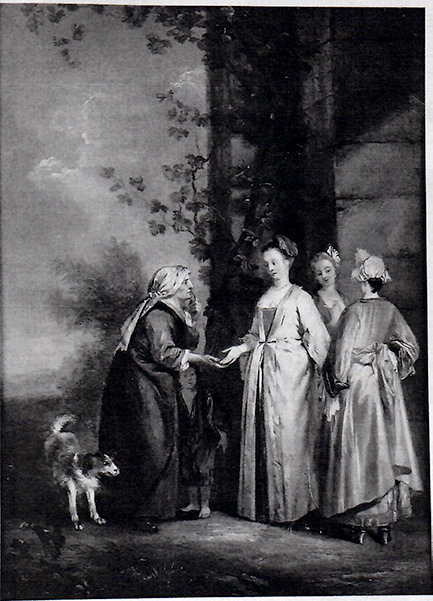
Whereabouts unknown
Oil on oak panel
40.5 x 30 cm
ALTERNATIVE TITLES
La Bonne aventure
La Diseuse de bonne aventure
PROVENANCE
Lille, Mercier, March 22, 1998, lot 294: “ÉCOLE FRANÇAISE du XVIIIe siècle, d’après une gravure de Watteau / La diseuse de bonne aventure / Huile sur panneau. 40,5 x 30 cm / Voir la reproduction.”
Paris, sale, Nouveau Drouot (Tajan), October 25, 2002, lot 119: “ÉCOLE FRANÇAISE DU XVIIIe SIÈCLE, SUIVEUR DE ANTOINE WATTEAU / LA DISEUSE DE BONNE AVENTURE / Panneau de chêne, une planche, non parqueté / 40.5 30 cm / 5000-6000€.”
Paris, sale, Nouveau Drouot (Beaussant Lefèvre), February 28, 2003, lot 28: “ÉCOLE FRANÇAISE DU XVIIIe SIÈCLE / La bonne aventure, d’après Antoine Watteau / Huile sur panneau. 40,5 x 30 cm / €3 000 / 3 500.” Sold for €3,500.
REMARKS
This picture copies Laurens Cars’ engraving.
La Diseuse d’aventure (copy 43)
Entered July 2020
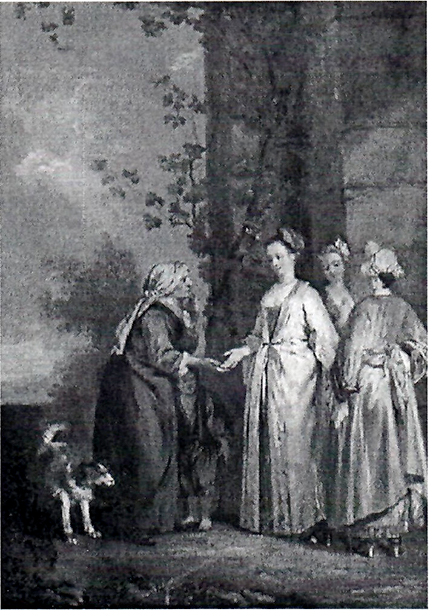
Whereabouts unknown
Oil on panel
15.9 x 11.8 cm
PROVENANCE
Paris, sale, Tajan, December 10, 1999, lot 88: “Circle of Philippe Mercier.”
La Diseuse d’aventure (copy 44)
Entered July 2020
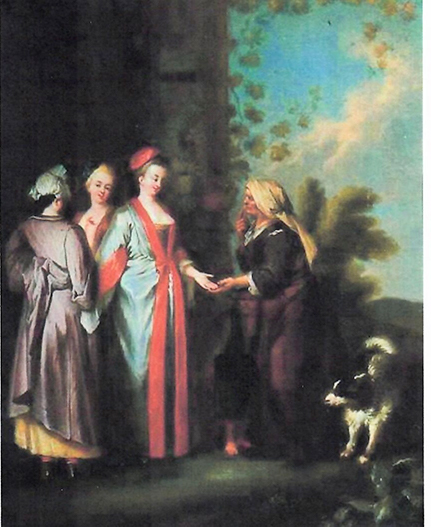
Whereabouts unknown
Oil on panel
33.4 x 27.7 cm
ALTERNATIVE TITLES
Bei der Wahrsagerin
PROVENANCE
Stuttgart, Nagel Auktionen, June 24, 2004, lot 618: Philip Mercier / Bei der Wahrsagerin, oil on panel, Height 13.1 in.; Width 10.9 in. / Height 33.4 cm.; Width 27.7 cm. estimate 5,000 EUR. Sold for 3,000 EUR (3,627 USD) hammer price.
REMARKS
The painting is executed in the same direction as Watteau’s original composition. One might wonder what model the copyist followed. He repeated Watteau’s colors of rose and pale blue for the principal woman’s costume, but not Watteau’s colors for the woman at the left.
La Diseuse d’aventure (copy 45)
Entered March 2021

Whereabouts unknown
Oil on canvas
73 x 60 cm
ALTERNATIVE TITLES
La Diseuse de bonne aventure
PROVENANCE
Paris, collection of Monsieur L. His sale and others, Hôtel Drouot, October 17-18, 1919, lot 68: “WATTEAU (D’après Antoine) . . . La Diseuse de bonne aventure. Toile. Haut., 73 cent.; larg. 60 cent. Cadre en bois sculpté ancien. Redoré.”
REMARKS
The extremely large size of this picture allies it with our copy 5. However, that painting was traditionally given to Watteau whereas when this copy was at auction it was described as being after the master, a demotion that suggests it was a different work.
La Diseuse d’aventure (copy 46)
Entered June 2021
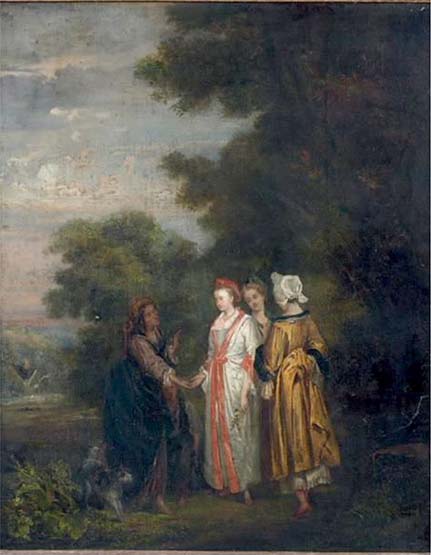
Whereabouts unknown
Oil on canvas
90 x 72 cm
ALTERNATIVE TITLES
La Diseuse de bonne aventure
PROVENANCE
Sale, Paris, Hôtel Drouot (Claude Lucien et Aude Moyano), May 17, 2013, lot 93: “École ANGLAISE du XIXe siècle, suiveur d’Antoine WATTEAU / La diseuse de bonne aventure / Toile. 90 x 72 cm. (Restaurations anciennes). Dans un cadre en bois sculpté et redoré, travail français d’époque Louis XV. 1 200 / 1 500.”
REMARKS
One wonders why this copy after Laurent Cars’ engraving of Watteau’s composition was attributed to the English school. Unlike most copies, this example omits Watteau’s wall and, instead, depicts shrubbery behind the women.
For La Diseuse d’aventure CLICK HERE
